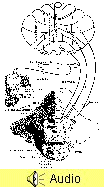Deep
Nuclei
![]() Intro
Intro
|
Deep Nuclei |
 Now that we know
something about the inputs to the Purkinje cells, let's look
at the distribution of their axons. Purkinje cells in the
four different zones, MEDIAL, INTERMEDIATE, LATERAL AND
FLOCCULONODULAR, project to different deep cerebellar
nuclei. Three of the four deep cerebellar nuclei can be seen
below in an old friend from the brain stem, level 5. You
have not seen the dorsal part of this section before, but it
shows three of the four sets of deep cerebellar
nuclei. The most lateral deep cerebellar nucleus,
the dentate, receives its Purkinje cell input from
the lateral zone of the cerebellum. Remember that
this lateral zone of the cerebellum receives its
input from olivocerebellar and pontocerebellar fibers
carrying planning information from the posterior parietal
area. The interpositus nucleus (globose and
emboliform) receives its Purkinje cell input from the
intermediate zone of the cerebellum. The
intermediate zone of the cerebellum receives its
input from olivocerebellar and pontocerebellar fibers
carrying information from primary motor cortex (area 4)
AND from the DSCT and CCT. The Purkinje cells that
innervate the medially located fastigial nucleus lie
in the medial zone of the cerebellum which, as you
remember, receives input from the DSCT and CCT (and the
olive!).
Now that we know
something about the inputs to the Purkinje cells, let's look
at the distribution of their axons. Purkinje cells in the
four different zones, MEDIAL, INTERMEDIATE, LATERAL AND
FLOCCULONODULAR, project to different deep cerebellar
nuclei. Three of the four deep cerebellar nuclei can be seen
below in an old friend from the brain stem, level 5. You
have not seen the dorsal part of this section before, but it
shows three of the four sets of deep cerebellar
nuclei. The most lateral deep cerebellar nucleus,
the dentate, receives its Purkinje cell input from
the lateral zone of the cerebellum. Remember that
this lateral zone of the cerebellum receives its
input from olivocerebellar and pontocerebellar fibers
carrying planning information from the posterior parietal
area. The interpositus nucleus (globose and
emboliform) receives its Purkinje cell input from the
intermediate zone of the cerebellum. The
intermediate zone of the cerebellum receives its
input from olivocerebellar and pontocerebellar fibers
carrying information from primary motor cortex (area 4)
AND from the DSCT and CCT. The Purkinje cells that
innervate the medially located fastigial nucleus lie
in the medial zone of the cerebellum which, as you
remember, receives input from the DSCT and CCT (and the
olive!).
 Purkinje cells in the
flocculonodular zone (or lobe) also need a deep nucleus.
Gee, where is it? Well, the Purkinje cells of the
flocculonodular lobe terminate in the VESTIBULAR NUCLEI,
which we can consider as a "surrogate" deep cerebellar
nucleus. These Purkinje cells that are destined for the
vestibular nuclei travel in the inferior cerebellar peduncle
(along with the fibers from the vestibular nerve and nuclei
that are entering the cerebellum.)
Purkinje cells in the
flocculonodular zone (or lobe) also need a deep nucleus.
Gee, where is it? Well, the Purkinje cells of the
flocculonodular lobe terminate in the VESTIBULAR NUCLEI,
which we can consider as a "surrogate" deep cerebellar
nucleus. These Purkinje cells that are destined for the
vestibular nuclei travel in the inferior cerebellar peduncle
(along with the fibers from the vestibular nerve and nuclei
that are entering the cerebellum.)
 The signals from the
Purkinje cells that terminate in the deep cerebellar nuclei
are inhibitory. Think of the inhibitory signal as increasing
or decreasing depending upon what is happening in the
cerebellum. Also remember that the deep cerebellar nuclei
also receive EXCITATORY inputs from the collaterals
of both mossy and climbing fibers as they pass through the
deep white matter on their way to the overlying cerebellar
cortex. The interplay of the inhibitory (Purkinje cell) and
excitatory (mossy and climbing fiber) inputs to the deep
nuclei determines their output signal to the other parts of
the brain that we will discuss next.
The signals from the
Purkinje cells that terminate in the deep cerebellar nuclei
are inhibitory. Think of the inhibitory signal as increasing
or decreasing depending upon what is happening in the
cerebellum. Also remember that the deep cerebellar nuclei
also receive EXCITATORY inputs from the collaterals
of both mossy and climbing fibers as they pass through the
deep white matter on their way to the overlying cerebellar
cortex. The interplay of the inhibitory (Purkinje cell) and
excitatory (mossy and climbing fiber) inputs to the deep
nuclei determines their output signal to the other parts of
the brain that we will discuss next.